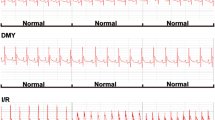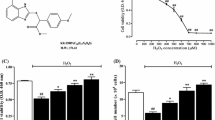Abstract
Myocardial ischemia–reperfusion injury (MI/RI), a complication of myocardial injury, is associated with high rates of mortality and disability. We aimed to explore the effect of nicorandil™ against MI/RI and investigated the underlying molecular mechanisms. In this in vitro study, hypoxia/reoxygenation (H/R) processing of H9c2 cells significantly suppressed the expressions of IL33 and ST2, reduced cell viability, increased production of reactive oxygen species, downregulated protein expression of Bcl-2, upregulated protein expressions of Bax, cleaved caspase3, and cleaved PARP, increased intracellular calcium overload, and induced cell apoptosis. Nicorandil processing reduced H/R-induced H9c2 cell damage. Nicorandil processing ameliorated the H/R-induced inhibition of the IL33 and ST2 expression in H9c2 cells. 5-Hydroxydecanoate blocked the effects of nicorandil on H9c2 cell viability, ROS production, and apoptosis and inhibited both IL33 and ST2. Similarly, the protective effect of nicorandil was restrained after inhibition of the IL33/ST2 pathway. Our findings suggest that the protective effect of nicorandil against H/R-induced H9c2 cell apoptosis was mediated through IL33/ST2 signaling pathway.





Similar content being viewed by others
Data availability
All data in this publication may be used without reservation.
References
Sun T, Cheng Y, Yan L, Krittanawong C, Qian W, Zhang H (2019) LncRNA MALAT1 knockdown alleviates myocardial apoptosis in rats with myocardial ischemia-reperfusion through activating PI3K/AKT signaling pathway. Eur Rev Med Pharmacol Sci 23:10523–10531
Yang M, Kong D, Chen J (2019) Inhibition of miR-148b ameliorates myocardial ischemia/reperfusion injury via regulation of Wnt/β-catenin signaling pathway. J Cell Physiol 234:17757–17766
Zhou R, Jia Y, Wang Y, Li Z, Qi J, Yang Y (2021) Elevating miR-378 strengthens the isoflurane-mediated effects on myocardial ischemia-reperfusion injury in mice via suppression of MAPK1. Am J Trans Res 13:2350–2364
Neri M, Riezzo I, Pascale N, Pomara C, Turillazzi E (2017) Ischemia/Reperfusion Injury following Acute Myocardial Infarction: a critical issue for clinicians and forensic pathologists. Mediators Inflamm 2017:7018393
Gunata M, Parlakpinar H (2021) A review of myocardial ischaemia/reperfusion injury: Pathophysiology, experimental models, biomarkers, genetics and pharmacological treatment. Cell Biochem Funct 39:190–217
Chen Y, Fan H, Wang S, Tang G, Zhai C, Shen L (2021) Ferroptosis: a novel therapeutic target for ischemia-reperfusion injury. Front Cell Dev Biol 9:688605
Fukui Y, Nozawa T, Ihori H et al (2017) Nicorandil attenuates ischemia-reperfusion injury via inhibition of norepinephrine release from cardiac sympathetic nerve terminals. Int Heart J 58:787–793
Zhu H, Xu X, Fang X, Zheng J, Chen T, Huang J (2019) Effects of mitochondrial ATP-sensitive potassium channel activation (nicorandil) in patients with angina pectoris undergoing elective percutaneous coronary interventions: a meta-analysis of randomized controlled trials. Medicine 98:e14165
Carreira R, Monteiro P, Kowaltowski A, Gonçalves L, Providência L (2008) Nicorandil protects cardiac mitochondria against permeability transition induced by ischemia-reperfusion. J Bioenerg Biomembr 40:95–102
Wu H, Ye M, Yang J et al (2015) Nicorandil protects the heart from ischemia/reperfusion injury by attenuating endoplasmic reticulum response-induced apoptosis through PI3K/Akt signaling pathway. Cell Physiol Biochem : Int J Exp Cell Physiol, Biochem, Pharmacol 35:2320–2332
Ruisong M, Xiaorong H, Gangying H et al (2015) The protective role of interleukin-33 in myocardial ischemia and reperfusion is associated with decreased HMGB1 expression and up-regulation of the P38 MAPK Signaling pathway. PloS one 10:e0143064
He W, Su Q, Liang J, Sun Y, Wang X, Li L (2018) The protective effect of nicorandil on cardiomyocyte apoptosis after coronary microembolization by activating Nrf2/HO-1 signaling pathway in rats. Biochem Biophys Res Commun 496:1296–1301
Wang A, Chen F, Xie Y, Guo Z, Yu Y (2012) Protective mechanism of nicorandil on rat myocardial ischemia-reperfusion. J Cardiovasc Med (Hagerstown, Md) 13:511–515
Wang X, Pan J, Liu D et al (2019) Nicorandil alleviates apoptosis in diabetic cardiomyopathy through PI3K/Akt pathway. J Cell Mol Med 23:5349–5359
Cadenas S (2018) ROS and redox signaling in myocardial ischemia-reperfusion injury and cardioprotection. Free Radical Biol Med 117:76–89
Ibáñez B, Heusch G, Ovize M, Van de Werf F (2015) Evolving therapies for myocardial ischemia/reperfusion injury. J Am Coll Cardiol 65:1454–1471
Chen C, Hong H, Hao W, Cheng T, Liu J, Sung L (2019) Nicorandil prevents doxorubicin-induced human umbilical vein endothelial cell apoptosis. Eur J Pharmacol 859:172542
Jia D (2011) The protective effect of mitochondrial ATP-sensitive K+ channel opener, nicorandil, combined with Na+/Ca2+ exchange blocker KB-R7943 on myocardial ischemia-reperfusion injury in rat. Cell Biochem Biophys 60:219–224
Seki K, Sanada S, Kudinova A et al (2009) Interleukin-33 prevents apoptosis and improves survival after experimental myocardial infarction through ST2 signaling. Circ Heart Fail 2:684–691
Yin H, Li P, Hu F, Wang Y, Chai X, Zhang Y (2014) IL-33 attenuates cardiac remodeling following myocardial infarction via inhibition of the p38 MAPK and NF-κB pathways. Mol Med Rep 9:1834–1838
Zhao XT, Zhang CF, Liu QJ (2019) Meta-analysis of Nicorandil effectiveness on myocardial protection after percutaneous coronary intervention. BMC Cardiovasc Disord 19:144
Lu Y, Hu W, Song Q, Wang Q (2020) The efficacy and safety of nicorandil for periprocedural myocardial injury in patients undergoing PCI: a meta-analysis. J Interv Cardiol 2020:3293587
Xu L, Wang L, Li K, Zhang Z, Sun H, Yang X (2019) Nicorandil prior to primary percutaneous coronary intervention improves clinical outcomes in patients with acute myocardial infarction: a meta-analysis of randomized controlled trials. Drug Des Devel Ther 13:1389–1400
Funding
The authors declare that no funds, grants, or other support were received during the preparation of this manuscript.
Author information
Authors and Affiliations
Contributions
Y Z, XY L and FZ performed the experiments; B Z, WTD, and D S performed data analysis; Y Z, XYL and GP L designed the study; Y Z and GP L wrote the manuscript. All authors read and approved the final manuscript.
Corresponding author
Ethics declarations
Conflict of interests
The authors have no relevant financial or non-financial interests to disclose.
Ethical approval
Not applicable.
Informed consent
Not applicable.
Consent to publication
Not applicable.
Additional information
Publisher's Note
Springer Nature remains neutral with regard to jurisdictional claims in published maps and institutional affiliations.
Rights and permissions
About this article
Cite this article
Zheng, Y., Li, X., Zhang, F. et al. Protective effect of nicorandil against myocardial ischemia/reperfusion injury mediated via IL33/ST2 signaling pathway. Mol Cell Biochem 477, 1921–1929 (2022). https://doi.org/10.1007/s11010-022-04418-z
Received:
Accepted:
Published:
Issue Date:
DOI: https://doi.org/10.1007/s11010-022-04418-z




